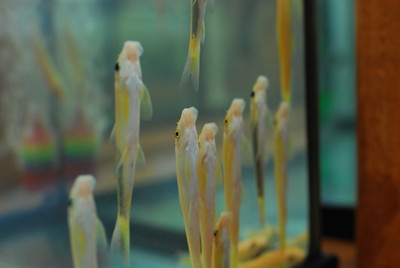Exploring the Chinese Algae Eater: A Comprehensive Guide to Care and Characteristics
Posted by Max Gandara on on 29th Feb 2024
Physical Characteristics:
The Chinese Algae Eater is easily recognized by its slender, elongated body and distinctive golden coloration. Adult fish can reach lengths of up to 10 inches (25 centimeters). They have a sucker-like mouth located on the underside of their body, which helps them cling to surfaces while feeding on algae. The Chinese Algae Eater also features a dark stripe running along its lateral line, contributing to its overall striking appearance.
Habitat and Natural Range:
Originating from the rivers and streams of Southeast Asia, including countries like Thailand, Vietnam, and Laos, the Chinese Algae Eater is commonly found in freshwater environments with moderate to strong currents. In the wild, they inhabit areas with plenty of vegetation, rocky substrates, and driftwood. Recreating these conditions in captivity is essential for their well-being.
Tank Requirements:
Chinese Algae Eaters require a well-equipped aquarium with ample space for swimming and hiding. A tank size of at least 30 gallons is recommended, especially considering their potential adult size. Providing a substrate of fine gravel or sand, along with driftwood and rocks for hiding places, mimics their natural habitat.
Filtration is crucial to maintain good water quality, as these fish can produce a significant amount of waste. The water temperature should be kept between 75°F to 82°F (24°C to 28°C), and the pH level should be maintained between 6.5 to 7.5. Regular water changes help ensure optimal conditions for their health and longevity.
Diet and Feeding:
The primary appeal of the Chinese Algae Eater is its ability to consume algae, making it a popular choice for aquariums dealing with unwanted algae growth. However, it's essential to supplement their diet with other foods, as they may become less interested in algae as they grow older.
In addition to algae-based flakes or pellets, provide a varied diet that includes high-quality sinking pellets, vegetable matter, and occasional live or frozen foods such as brine shrimp or bloodworms. Ensuring a balanced and nutritious diet contributes to their overall health and vitality.
Behavior:
Chinese Algae Eaters are generally peaceful but can become territorial as they mature. It's advisable to keep them in groups of at least three individuals to help distribute any territorial behavior. However, they can become aggressive towards other bottom-dwelling fish with similar appearances or body shapes, so careful consideration should be given to tankmates.
While these fish are effective algae eaters, their behavior may change as they grow older. Some Chinese Algae Eaters may become less interested in algae and more territorial, necessitating attention to their social dynamics within the tank.
Challenges and Considerations:
One challenge with the Chinese Algae Eater is that some individuals may become less effective at consuming algae as they age. Additionally, they may exhibit aggressive behavior, particularly if kept in small groups or with incompatible tankmates. It's crucial to monitor their behavior and address any signs of aggression or stress promptly.
The Chinese Algae Eater, with its algae-eating prowess and distinctive appearance, can be a valuable addition to a well-maintained aquarium. With proper care, attention to their social needs, and a balanced diet, these fish can contribute to a healthy and harmonious aquatic environment. As with any aquarium species, understanding their natural behaviors and providing appropriate conditions will lead to a rewarding and enjoyable experience for aquarists of all levels.

